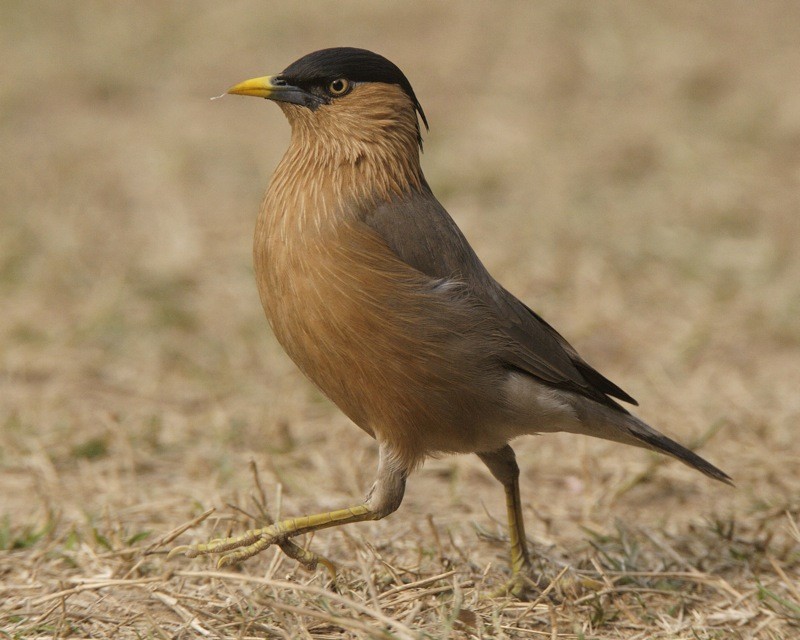Brahminy Starling
A species of Southern Asian Starlings Scientific name : Sturnia pagodarum Genus : Southern Asian Starlings
Brahminy Starling, A species of Southern Asian Starlings
Botanical name: Sturnia pagodarum
Genus: Southern Asian Starlings
Content
Description General Info
 Photo By Lip Kee Yap , used under CC-BY-SA-2.0 /Cropped and compressed from original
Photo By Lip Kee Yap , used under CC-BY-SA-2.0 /Cropped and compressed from original Description
This myna is pale buff creamy with a black cap and a loose crest. The bill is yellow with a bluish base. The iris is pale and there is a bluish patch of skin around the eye. The outer tail feathers have white and the black primaries of the wings do not have any white patches. The adult male has a more prominent crest than the female and also has longer neck hackles. Juveniles are duller and the cap is browner. The species name pagodarum is thought to be based on occurrence of the species on buildings and temple pagodas in southern India. 
Size
20 cm
Nest Placement
Cavity
Feeding Habits
Brahminy Starling predominantly consume insects, such as grasshoppers and termites, and a variety of fruits and nectar. They exhibit foraging behaviors on the ground and in trees, often associated with other starlings. Nestlings are fed mostly animal matter. Unique adaptations include a specialized tongue for nectar consumption.
Habitat
Brahminy Starling typically inhabits open deciduous forests, scrub, and cultivated lands, often residing near human settlements. Their preferred environments include regions with waterlogged or marshy terrain. Geographically, they are widespread across various elevations, from lowlands to hilly areas up to 1800 meters. Although these birds are mainly found on plains, they occasionally venture to altitudes above 3000 meters, such as in Ladakh.
Dite type
Omnivorous
General Info
Feeding Habits
Bird food type
Behavior
Like most starlings, the brahminy starling is omnivorous, eating fruit and insects. They have been known to feed on the fruits of Thevetia peruviana which are toxic to many vertebrates. These birds are not as arboreal as the grey-headed mynas and they form small flocks that mix with other mynas on grass covered ground. They sometimes forage beside grazing cattle. They also visit flowers for nectar, particularly Salmalia, Butea monosperma and Erythrina. They roost communally in large numbers in leafy trees, often in the company of parakeets and other mynas. It builds its nest in tree holes or artificial cavities. The breeding season is March to September but varies with location, being earlier in southern India. The season coincides with the fruiting of many plants and the young hatch just as the rains begin. The male selects the nest, sometimes having to compete with other hole-nesters such as barbets and sparrows. The male displays by puffing up feathers, fanning the tail, erecting the crest and raising up its bill. Both sexes take part in nest building. The nest is lined with grass, feathers and rags. The normal clutch is three to four eggs which are pale bluish green. The females do not add replacement eggs when eggs are removed nor do they stop laying if an egg is artificially added. Incubation begins only after laying the second egg with the female brooding at night with the male share limited to brief periods during the day. The eggs hatch in about 12 to 14 days. The young fledge and leave the nest when they are three weeks old. The young are fed with insects in the early stages and grains in the later stages. After feeding the parents wait for the young to eject faecal pellets which they carefully remove and drop about 20 metres (66 ft) away from the nest. Two or three broods may be raised in succession. 
Distribution Area
It is a resident breeder in Nepal and India, a winter visitor to Sri Lanka and a summer visitor in parts of the western Himalayas and northeastern Himalayas. They are spotted in plains of Pakistan as well. They have musical call notes that are long made up of a series of slurred notes that ends abruptly. Although mainly seen on the plains there are a few records from above 3000m mainly from Ladakh. This passerine is typically found in dry forest, scrub jungle and cultivation and is often found close to human habitations. They especially favour areas with waterlogged or marshy lands. 
Species Status
Not globally threatened.
Scientific Classification
Phylum
Chordates Class
Birds Order
Perching birds Family
Starlings Genus
Southern Asian Starlings Species
Brahminy Starling